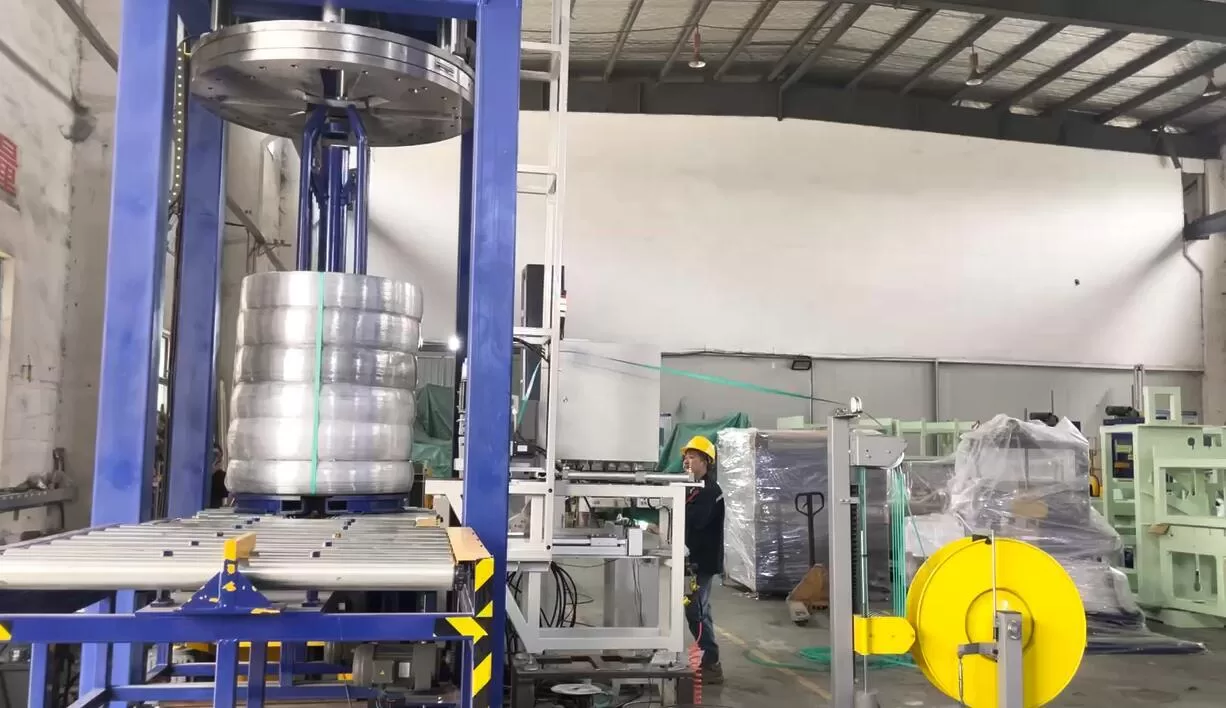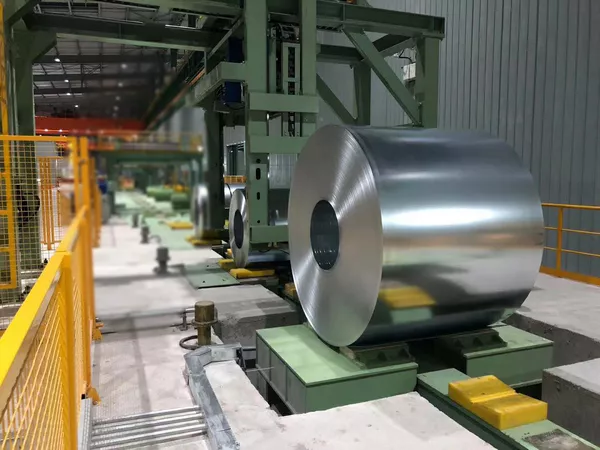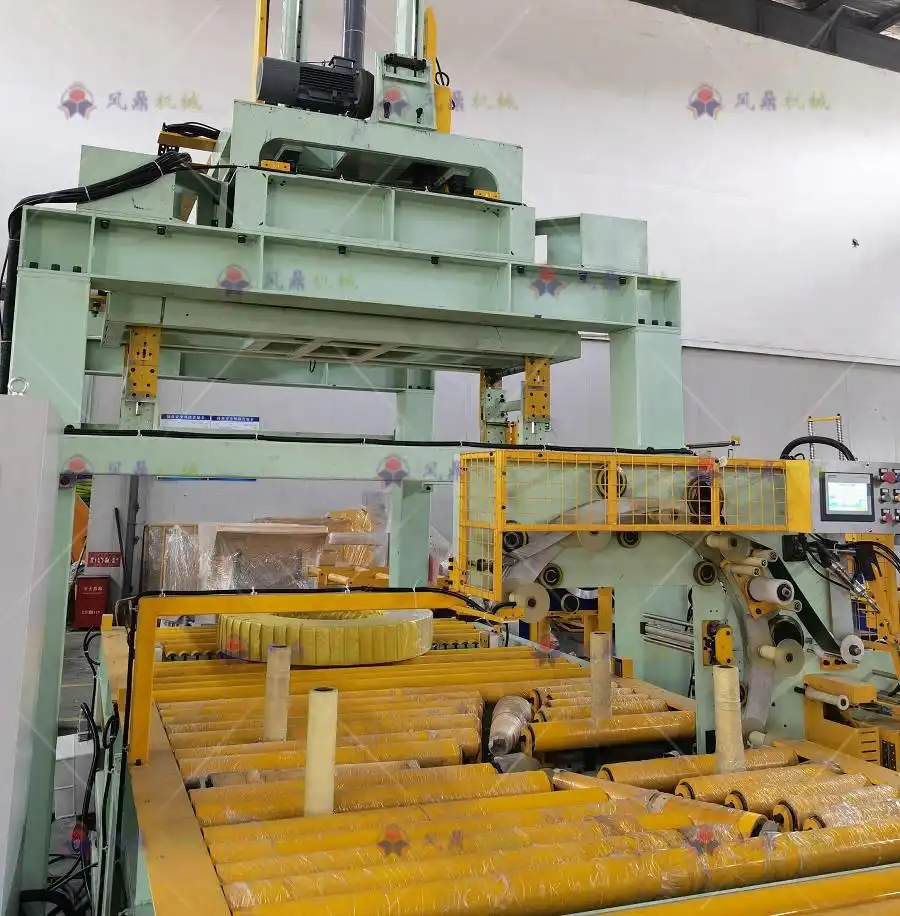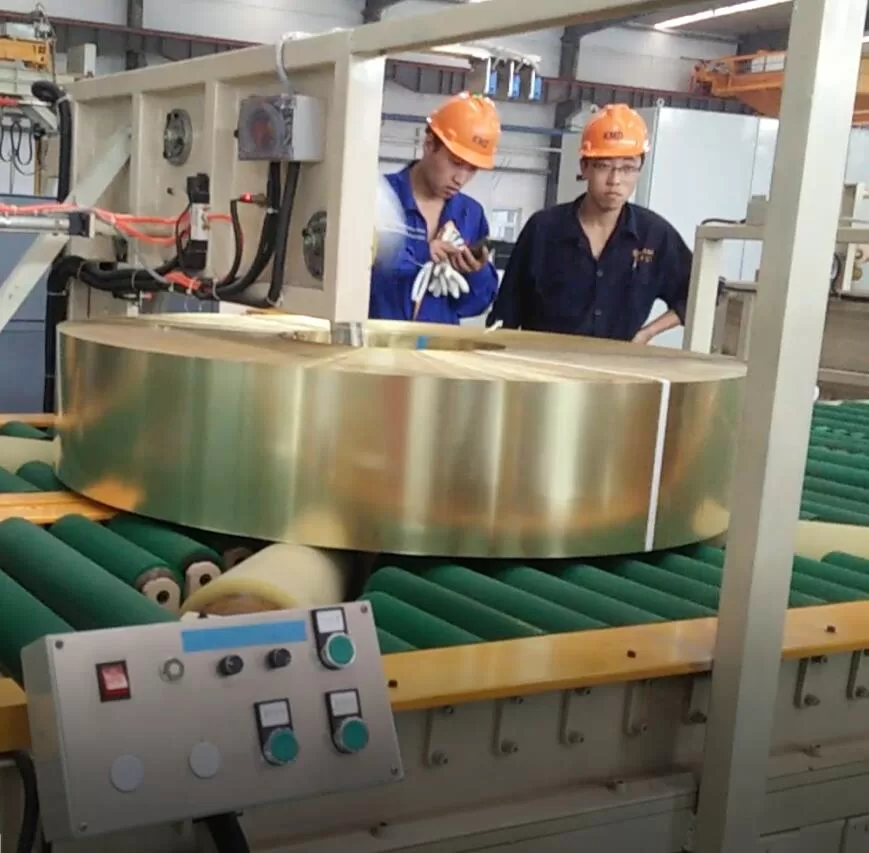Are you running a steel mill or a large manufacturing plant? You probably feel the constant pressure. The pressure to increase output, cut costs, and adapt to changing market demands. Your packing line is often the final, critical step before your product reaches the customer. A breakdown or bottleneck here can bring your entire operation to a halt. I've seen it happen many times. A rigid, outdated packing line acts like an anchor, holding back your growth and eating into your profits. You know you need a change, but the thought of a massive, disruptive overhaul is overwhelming.
Modular steel coil packing lines are becoming popular in Indonesia's manufacturing sector because they offer superior flexibility, scalability, and cost-effectiveness. These systems allow companies to start with a basic setup and add new functions or capacity as their needs grow. This "pay-as-you-grow" approach avoids massive upfront investment and minimizes disruption. It also makes maintenance and upgrades simpler, reducing downtime and future-proofing the operation against new technologies.

I've spent over two decades in this industry, first as an engineer on the factory floor and now as the owner of SHJLPACK. I've seen firsthand how the right equipment can make or break a business. The trend we are seeing in a fast-growing market like Indonesia is not just a local phenomenon. It is a blueprint for the future of industrial packaging everywhere. These principles of flexibility and smart investment are universal. In this article, I want to break down exactly why modular systems are taking over. I will share my experience to help you understand if this approach is right for your facility.
How Do Modular Designs Address Space and Scalability Challenges?
Your factory floor is valuable real estate. Every square meter is accounted for. But what happens when you need to increase your packing capacity or add a new process, like a different type of wrapping or labeling? With a traditional, one-piece packing line, you're stuck. You either face a massive, space-consuming installation or you conclude that it's simply not possible. This limitation directly caps your growth potential and your ability to respond to new customer requirements.
A modular design solves this problem by breaking down the packing line into independent, connectable units. This approach gives you the power to design a layout that fits your exact available space, even if it's an unusual shape. You can scale your operations up or down by simply adding or removing modules. This means you can increase capacity incrementally, matching your investment directly to your revenue growth, instead of making a huge bet on future demand.

Let's dive deeper into how this works in practice. I remember working with a client in Southeast Asia whose factory was in an older building with several support columns in the middle of the production floor. A traditional line was out of the question. It just wouldn't fit. This is a common problem for established mills that want to modernize.
Unlocking Layout Flexibility
A traditional packing line is a single, massive piece of machinery. It dictates the layout. You have to design your workflow around the machine. A modular line flips this around. You design the machine around your workflow.
Each module—be it a coil up-ender, a strapping machine, a wrapping station, or a weighing scale—is a self-contained unit. They can be connected in various configurations.
- L-Shape: You can arrange modules in an L-shape to fit into a corner.
- U-Shape: A U-shape can bring the start and end points of the line closer together, improving logistics for a single operator.
- Straight Line: If you have the space, a straight line is still the most efficient. But you are not forced into it.
This flexibility means you can optimize material flow, reduce the travel distance for forklifts, and create a safer, less congested work environment. You are no longer constrained by the machine's footprint.
Scaling with Your Business
Scalability is one of the biggest advantages. Let’s say you are a steel processor like Javier, and you just landed a new contract that requires you to double your output of slit coils.
| Feature | Traditional Line | Modular Line |
|---|---|---|
| Initial Setup | Buy a large line for max projected capacity. High upfront cost. | Buy only the modules you need now. Lower initial cost. |
| Scaling Up | Replace the entire line or face a major, complex retrofit. | Add another strapping or wrapping module in parallel. |
| Downtime for Upgrade | Weeks of shutdown for installation. | Minimal downtime. Install the new module offline, then connect it. |
| Scaling Down | The large machine runs inefficiently at low capacity. | Deactivate or remove a module to save energy and maintenance costs. |
This phased approach is much healthier for your cash flow. You invest in new capacity only when you have the orders to justify it. It transforms a large capital expenditure (CapEx) into a more manageable, staged investment. It allows you to be nimble and responsive, which is critical in a cyclical industry like steel.
What Are the Cost-Benefit Advantages of Modular Systems Over Traditional Lines?
Every factory owner, especially someone as experienced as Javier, scrutinizes every major purchase. The question is always: "What is the return on this investment?" On the surface, a single, integrated traditional packing line might sometimes seem cheaper. The quote might be a single, large number that looks simpler. But this is a trap. You are not just buying a machine; you are investing in a long-term operational asset. The real cost goes far beyond the initial price tag.
The primary cost-benefit advantage of a modular system lies in its total cost of ownership (TCO). While the initial purchase price of individual modules might add up, the savings in installation, scalability, maintenance, and future upgrades far outweigh the cost of a rigid, traditional line. It shifts your spending from large, risky capital outlays to predictable, manageable operational expenses that grow with your business.

To really understand this, we need to break down the costs over the entire lifecycle of the equipment. I always advise my clients to look beyond the initial invoice. Think like an owner, not just a purchasing manager. The initial price is just the tip of the iceberg. The hidden costs of a traditional system can sink your budget over time.
Deconstructing the Total Cost of Ownership
Let's compare a traditional line versus a modular line for a medium-sized steel service center. We will look at more than just the sticker price.
-
Initial Investment: A traditional line requires you to buy for your peak future demand. You might pay $1 million for a line that you only use at 50% capacity for the first three years. With a modular system, you might spend $600,000 today for what you need now. You save $400,000 in upfront capital, which can be used for other critical areas of your business. That capital can generate its own return.
-
Installation and Commissioning: Traditional lines are often shipped in large, difficult-to-handle sections. They require extensive foundation work, and installation can shut down a part of your plant for weeks. Modules are smaller, easier to transport, and can be installed much faster. We often install modules over a weekend, leading to minimal production loss.
-
Operational Costs: Modularity allows for greater energy efficiency. If you have a slow production day, you can power down specific modules that are not in use. A traditional line often runs its main motor and conveyor system regardless of throughput, wasting electricity. This directly addresses the challenge of fluctuating energy costs.
Future-Proofing and Upgrade Costs
This is where the modular approach truly shines and delivers the biggest financial benefit. Let's say in five years, a new, super-efficient wrapping material becomes available, but it requires a different type of heating element.
| Scenario | Traditional Line Action | Modular Line Action |
|---|---|---|
| Technology Change | Requires a complex, custom-engineered retrofit of the entire line. Costly and high-risk. | Swap out the old wrapping module for a new one. A simple, predictable upgrade. |
| New Regulation | Might require adding a new fume extraction system to the whole line. Difficult to integrate. | Add a new ventilation module specifically where it's needed. |
| Change in Product | If you start producing smaller coils, the large line might not handle them well. | Add a new, smaller strapping module dedicated to the new product size. |
With a traditional system, you are locked into the technology you buy today. With a modular system, your packing line can evolve with your business and the industry. You are not buying a static piece of metal; you are buying a flexible platform. This adaptability is not just a convenience; it's a powerful competitive advantage that reduces future financial risk.
How Does Modularity Enhance Maintenance and Reduce Downtime?
Downtime is the enemy of any profitable manufacturing operation. When your packing line stops, your finished products pile up, shipping schedules are missed, and customers get angry. With a traditional, interconnected packing line, a single failure can be catastrophic. A broken gearbox in one section can bring the entire system to a grinding halt. Finding the source of the problem can be a complex and time-consuming task, requiring specialized technicians.
Modularity dramatically improves maintenance and cuts downtime by isolating potential failures and simplifying the repair process. Because each module operates independently, a problem in one unit, like the wrapper, does not necessarily stop another unit, like the strapper. This allows for easier troubleshooting, faster repairs, and even the ability to bypass a malfunctioning module temporarily to keep production moving.

I’ve seen this firsthand. A client with a traditional line had a sensor fail deep inside the main control cabinet. It took two electricians six hours just to diagnose the problem because the wiring was a complex web connecting every part of the line. The entire line was down for a full shift. This is a common story, and it's incredibly costly. Let's explore how a modular approach prevents this kind of disaster.
Simplified Troubleshooting and Repair
Think of it like troubleshooting a problem with your home entertainment system. If your speakers don't work, you check the speaker connections. You don't assume the TV is broken. A modular packing line works on the same principle of isolation.
-
Decentralized Controls: Each module has its own PLC (Programmable Logic Controller) and control panel. An error code on the strapping module's screen points directly to a problem within that specific unit. You don't have to sift through hundreds of lines of code for the entire system. Your maintenance team can immediately focus their efforts on the right area.
-
Standardized Components: In our modular designs at SHJLPACK, we use standardized components across different modules wherever possible. This means your maintenance team needs to stock fewer spare parts. A motor or a sensor used in the wrapping station might be the same one used in the conveyor module. This simplifies inventory management and ensures you have the right part on hand when you need it.
The Power of Swapping and Redundancy
This is a game-changer for critical operations. Imagine your primary strapping machine needs a major overhaul that will take 24 hours.
| Maintenance Scenario | Traditional Line Impact | Modular Line Impact |
|---|---|---|
| Major Repair Needed | The entire line is down for the full 24 hours. No product can be packed. | Option 1: If space allows, you can have a spare module on standby. Swap the broken module out for the spare one in under an hour. Repair the broken one offline. |
| (Continued) | Production loss is massive. Customer deadlines are missed. | Option 2: Bypass the module. You can manually strap the coils after they are wrapped, allowing the rest of the line to continue running at a reduced, but not zero, capacity. |
| Preventive Maintenance | You have to shut down the whole line to perform PM on one section. | You can perform PM on one module while the others continue to operate or are on standby. You can schedule maintenance with much more flexibility. |
This ability to swap modules is the ultimate defense against unplanned downtime. It turns a potential multi-day shutdown into a minor inconvenience. For a steel mill owner like Javier, who aims for 95% equipment uptime, this feature is not a luxury; it is a necessity. It provides a level of operational resilience that a traditional, monolithic line can never offer.
Can Modular Packing Lines Adapt to Future Automation and Digitalization Trends?
The manufacturing world is changing fast. Words like "Industry 4.0," "IoT," and "Big Data" are no longer just buzzwords. They represent a fundamental shift in how modern factories are managed. As a forward-thinking owner, Javier knows he needs to embrace this digital transformation to stay competitive. The problem is, how do you connect a 15-year-old, purely mechanical packing line to a modern MES (Manufacturing Execution System)? It's difficult, expensive, and often impossible. You risk creating a "data island" at the end of your production line.
Modular packing lines are inherently designed to embrace future automation and digitalization. Each module acts as a "smart node" with its own controls and communication capabilities. This architecture makes it incredibly easy to integrate new sensors, connect to factory-wide software platforms like MES, and implement data analytics for predictive maintenance. You can upgrade your line's intelligence one module at a time, keeping pace with technology without replacing the entire system.

The jump to a fully digital factory can seem daunting. But a modular approach allows you to take it step-by-step. It’s a practical, low-risk path to building a truly smart factory. I believe this is the most important long-term benefit of modularity. It doesn't just solve today's problems; it prepares you for tomorrow's opportunities.
Building the "Plug-and-Play" Smart Factory
Think of each module as a device you are connecting to a network. The communication protocols, like Profinet or Ethernet/IP, act as the common language.
-
Data Collection: Each module can be equipped with its own set of IoT sensors to track key metrics. The wrapping module can track film consumption. The strapping module can count cycles. The conveyor module can measure runtime. This granular data is impossible to get from a single, dumb traditional line.
-
Integration with MES/ERP: Because each module can communicate over standard industrial networks, connecting the entire line to your MES or ERP system is straightforward. The data flows seamlessly. Your production planning team can see real-time packing status. Your inventory system can be automatically updated when a coil is finished. This creates total production visibility, a key goal for any modern CEO.
Paving the Way for Advanced Analytics
Once you are collecting data, you can start using it to make smarter decisions. This is where you can achieve significant cost savings and efficiency gains.
| Digital Goal | How Modularity Helps | Practical Example |
|---|---|---|
| Predictive Maintenance | Data from individual modules (e.g., motor temperature, vibration) can be analyzed to predict failures before they happen. | An algorithm detects that the motor on strapping head #2 is vibrating more than usual. The system automatically schedules maintenance for the next planned stop, preventing a sudden breakdown. |
| Process Optimization | You can analyze data from different modules to find bottlenecks. | Data shows the wrapping cycle is 10 seconds slower than the strapping cycle. You can focus on optimizing the wrapper, knowing it's the constraint. |
| Full Automation | The "plug-and-play" nature allows for easy integration of robotic arms for tasks like label application or palletizing. | You can add a robotic palletizing module at the end of the line without having to re-engineer the entire system. |
This step-by-step digitalization is far more practical and affordable than a massive, one-time factory overhaul. You can start by adding sensors to your most critical module, prove the ROI, and then expand the project across the entire line. It allows you to build your smart factory at your own pace, with your own budget, and in a way that makes sense for your specific operation.
What is My Core Belief on Modular Systems as a Factory Owner?
I'm often asked what I consider the single most important factor when choosing equipment. As someone who started on the floor and later built my own factory, my answer is always the same: control. As a business owner, you need control over your costs, your production schedule, and your future. A traditional, monolithic packing line takes that control away from you. It dictates your layout, it locks you into old technology, and a single failure can hold your entire business hostage.
My core belief is that modular systems give control back to the factory owner. It's not just an engineering concept; it's a business philosophy centered on flexibility, risk management, and intelligent growth. It allows you to make decisions based on your current needs and future goals, not on the limitations of a machine you bought ten years ago. This philosophy is the foundation of everything we build at SHJLPACK.
I built my business and achieved financial independence because I was able to adapt. When the market for one type of steel product slowed, I was able to pivot to another. My production line had to be as agile as my business strategy. I remember the early days in my own factory. We had a large contract that required a specific type of paper wrapping we didn't normally do. Instead of turning the business away, we worked with an engineering partner to build a small, add-on wrapping module that we could roll into our existing line when needed.
From Engineering Tactic to Business Strategy
That experience taught me a powerful lesson. The machine shouldn't be the master. It should be a tool that serves the business strategy. A modular approach embodies this.
-
Financial Control: You control your capital expenditure. You invest when it makes sense, aligning spending with revenue. This is crucial for managing the cyclical nature of the steel industry. It turns a massive, risky bet into a series of smaller, safer steps.
-
Operational Control: You control your downtime. With swappable modules and simplified diagnostics, you are no longer at the mercy of a single, complex machine. You can schedule maintenance proactively and recover from failures in minutes or hours, not days. This directly supports the goal of achieving 95% uptime.
-
Strategic Control: You control your future. You can adopt new technologies, respond to new market demands, and comply with new regulations without throwing away your initial investment. Your packing line becomes an evolving asset, not a depreciating liability.
A Partnership, Not a Purchase
This is why I tell people like Javier that they should not be looking for a supplier. They should be looking for a partner. A true partner understands that their success is tied to your success. They don't just sell you a machine. They provide a platform that helps your business grow and adapt for years to come.
When I look at a modular packing line, I don't just see steel, motors, and wires. I see a physical manifestation of a smart, agile business strategy. It represents the freedom to choose your own path, to scale at your own pace, and to build a resilient operation that can thrive in an uncertain world. This, to me, is the real reason why modular systems are the future. It’s about empowering the owner.
Conclusion
Ultimately, modular packing lines offer a strategic advantage. They provide the flexibility, scalability, and future-ready platform that modern manufacturers in Indonesia and across the globe need to thrive.





